Undoubtedly, introducing nuts to a baby can be scary, as they pose both a choking hazard and rank among the top nine allergens.
However, introducing nuts to your baby between the ages of 6 and 12 months can actually help lower their chances of developing an allergy. So, how can you safely introduce nuts to your baby?
WHAT CAUSES AN ALLERGY

An allergy occurs when the immune system erroneously recognizes a protein in a specific food as a potential threat. Subsequently, the immune system becomes activated and releases substances like histamines to combat this perceived danger. This immune response triggers inflammation, which results in the symptoms of an allergic reaction.
BENEFITS OF NUTS FOR BABY
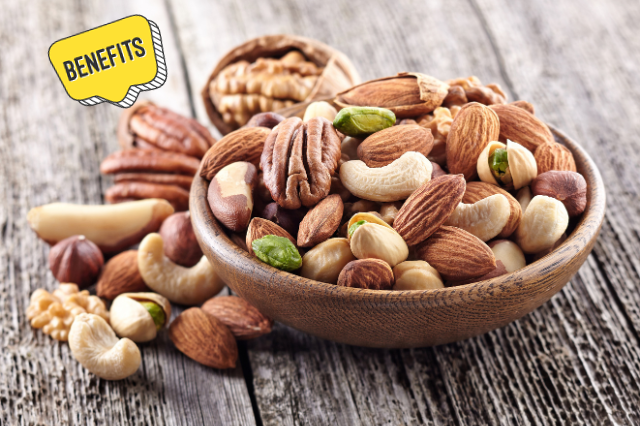
Nuts offer a wealth of nutrients and health benefits, and there are numerous ways to include them in a baby’s diet.
Different nuts have different nutrient profiles, but generally, they are rich in fats crucial for a baby’s growth and development. Additionally, they provide essential protein for muscle growth and tissue repair, along with fiber to support a healthy digestive system. Nuts are also a source of important micronutrients such as calcium, iron, folate, vitamin E, zinc, and more.
WHEN TO INTRODUCE PEANUTS AND OTHER NUTS TO BABY
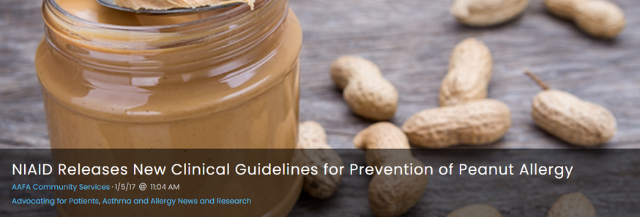
Back in 2000, parents were advised to avoid the introduction of allergenic foods for the first 1 to 3 years of life, with the belief that this would reduce the risk of developing allergies. However, recent research has shed light on this matter, revealing that delaying the introduction of allergenic foods not only fails to provide protection against allergies but can actually raise the risk of developing them.
A significant study called the LEAP study, conducted in England from 2006 to 2014, focused on infants at high risk of developing peanut allergies, including those with severe eczema, an egg allergy, or both. This study found that babies who were introduced to peanuts before the age of one and consumed them regularly in their diet had an 86% reduction in peanut allergy compared to children who avoided peanut.
Specifically, the group of children who avoided peanuts had a 17% incidence of peanut allergy, while the group that regularly included peanuts had a substantially lower rate of 3%. These findings underscore the importance of early and consistent introduction of allergenic foods like peanuts to reduce the risk of allergies in high-risk infants.
In early 2017, the National Institute of Allergy and Infectious Diseases (NIAID) release new guidelines specifically addressing peanut allergies. These guidelines received endorsement from prominent organizations such as the American Academy of Pediatrics, National Institute of Health and the American Academy of Allergy, Asthma, and Immunology, Malaysian Society of Allergy and Immunology , Canadian Society of Allergy and Clinical Immunology .
These guidelines recommend the introduction of allergenic foods at around 6 months of age, when babies are developmentally ready for solids (not before 4 months), and that all babies should have these foods by 12 months. This includes babies at high risk of allergy, unless an allergy to that particular food has already been confirmed.
Furthermore, once allergenic foods are introduced, it is beneficial to continue to offering them regularly, approximately twice a week. This practice helps in maintaining tolerance and reducing the risk of developing allergies.
WHAT NUTS CAN BE INTRODUCED TO BABY
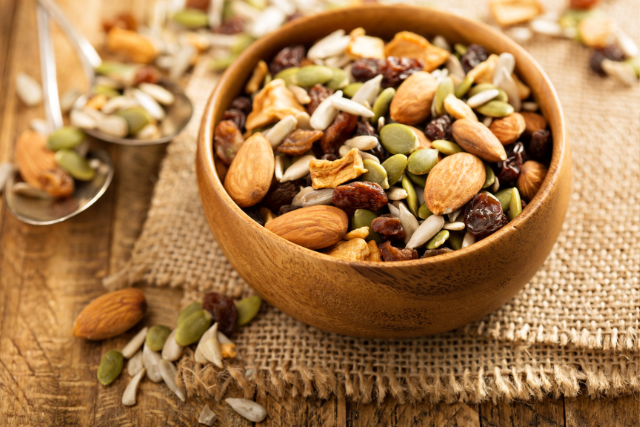
PEANUTS VS TREE NUTS
Peanuts and tree nuts, despite both being categorized as ‘nuts,’ do not share a botanical relationship and originate from distinct plant families. Surprisingly, peanuts aren’t true nuts; they belong to the legume family, such as soybeans, chickpeas or kidney beans. Interestingly, most individuals with a peanut allergy can typically consume other legumes safely.
- Peanuts
- Almonds
- Brazil nuts
- Cashews
- Chestnuts
- Hazelnuts
- Macadamia nuts
- Pine nuts
- Pecans
- Pistachios
- Walnuts
We know that peanuts are not related to tree nuts, so most people tend to be allergic to either peanuts OR tree nuts. However, approximately 1 in 3 individuals with a nut allergy are allergic to both peanuts and tree nuts.
It’s now known that there is some cross-reactivity can occur between different foods, as well as between pollen and certain foods or latex and certain foods. So, having a tree nut allergy doesn’t necessarily indicate an allergy to all types of tree nuts, but it significantly increases the risk of being allergic to others. For this reason, each type of nut needs to be introduced separately, ideally leaving 2-3 days between each one.
NUT BUTTERS
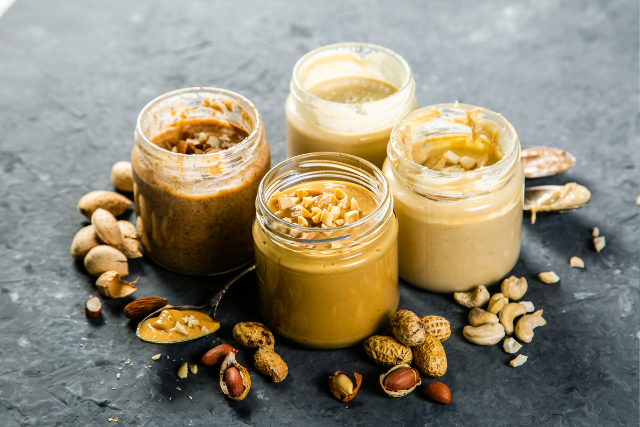
You have the option to prepare your own nut butter or purchase a commercially available brand of any of the nuts listed above. If opting for a store-bought variety, ensure that it is free from any additives like sugar, salt, oils, or preservatives. It should only contain the specific nut you intend to introduce.
After individually introducing each type of nut to your baby, using mixed nut butter can be a convenient method to continue exposing your baby to a variety of nuts simultaneously, rather than incorporating each nut separately. This approach simplifies the process of diversifying your baby’s nut consumption while ensuring they receive a broad range of nut-related nutrients.
A useful tip for nut butter: If your nut butter is too thick and clumpy, you can transfer a small amount to a microwave-safe bowl and heat it in 20-second intervals, stirring each time, until it becomes slightly warm. The heat will aid in smoothing out the nut butter and making it thinner in consistency.
GROUND OR FINELY CHOPPED NUTS
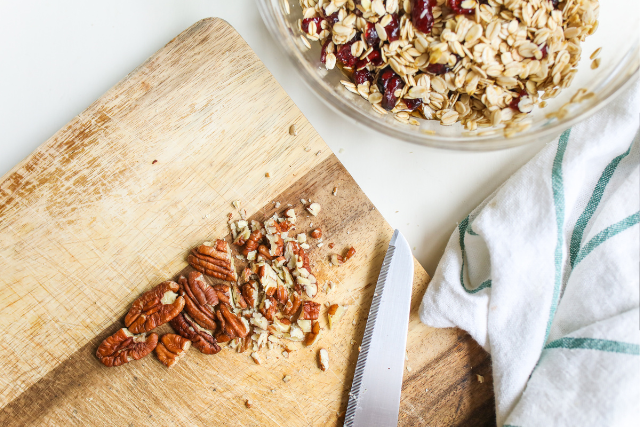
Another way to introduce nuts to your baby is by finely grinding them and then sprinkling them on top of pureed foods, oat cereal, avocado, banana, or other solid foods. To grind the nuts, you can take a small handful and pulse them in a blender or food processor until they are finely chopped. It’s essential to check the size of the nuts while pulsing every 20 seconds to avoid turning them into a paste or nut butter. Alternatively, you can finely chop a small quantity of nuts on a cutting board. Once you have the finely chopped nuts, you can sprinkle them onto your baby’s food, leave them as they are, or stir them in for added texture and flavor.
ARE NUTS A CHOKING HAZARD FOR BABY?

Whole nuts pose a choking hazard and should not be offered to children under the age of 4. Additionally, chunky nut butter with large lumps should be avoided for the same reason. To ensure safety, serve nuts to young children in alternative forms such as puffs, nut powder, finely chopped, in the form of flours, thinned nut butter, or incorporated into purees. These preparations minimize the risk of choking and make nuts more suitable for young children’s consumption.
ARE NUTS A COMMON ALLERGEN?

Peanuts and tree nuts are all classified as top food allergens, so it’s important to be vigilant about any potential reactions when introducing foods containing nut ingredients to your baby. Allergic reactions can occur within minutes to hours after consumption, so it’s advisable to offer such foods at a time when you can closely monitor your child for a few hours, rather than during dinner.
Be attentive to possible symptoms of an allergic reaction, which may include itchy rashes, hives, vomiting, difficulty breathing, swelling of the lips and tongue, and, in severe cases, anaphylaxis. If any of these symptoms occur, promptly contact your pediatrician. In the case of anaphylaxis, call for help immediately.
FEEDING TIPS WHEN INTRODUCING NUTS
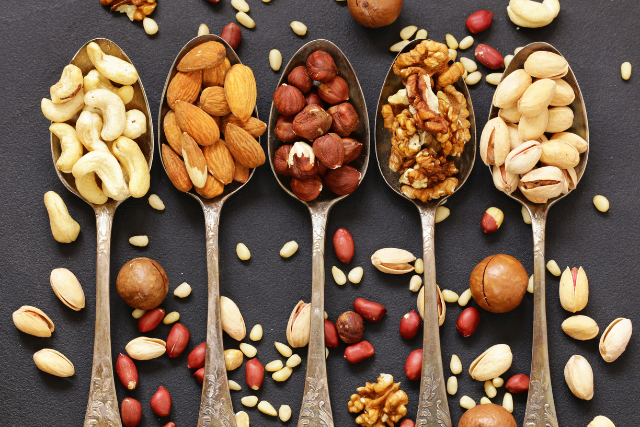
- Nuts pose a choking hazard for babies and young children, so it’s important to avoid offering whole nuts, chunks of nuts, or large dollops of nut butter to ensure their safety.
- Serve nuts earlier in the day: When introducing a new type of nut, offer it during breakfast or lunch so you can closely monitor your baby for any potential allergic reactions.
- Start with a small amount: You don’t need to give your baby a large serving to check for reactions. Begin with a small quantity to gauge their tolerance.
- Never rub on your baby’s skin: This will not help to identify a food allergy and can actually increase the risk of an allergy developing.
- Keep it on the menu: After successfully introducing a specific type of nut into your baby’s diet, aim to include it regularly in their weekly meal plan. This consistent exposure can potentially reduce the risk of developing allergies later in life.
HOW TO INTRODUCE PEANUTS OR TREE NUTS TO BABY

Begin by introducing one type of nut early in the day, allowing you to closely monitor for any potential symptoms. To ensure safety and to thoroughly assess for any overlooked reactions, it is recommended to reintroduce the same variety of tree nuts or peanuts the following day, preferably around the same time. To monitor any allergy reactions, it’s best to wait 1-2 days before switching to a different type of nut.
Here are some of my favourite ways to introduce peanuts and tree nuts to your baby’s diet:
FOR TRADITIONAL WEANING
- Add a small amount of warm water to a teaspoon of nut butter. Blend until you reach a smooth consistency, never serve a globs of nut butter as it can pose a choking hazard for young children.
- Infant cereal or oatmeal: Mix nut butter or finely chopped nuts into baby’s meal for added flavor and nutrition.
- Purees: Add a small amount of nut butter or finely chopped nuts to homemade baby purees for added texture and nutrition.
- Smoothies: Blend nut butter into a fruit or yogurt smoothie for a creamy, nutty flavor.
FOR BABY LED WEANING OR FINGER FOODS
- Pasta tossed with pesto (if making at home, you can change which nuts or seeds you use as the base).
- Nut butter thinly spread on toast, pancakes, or waffles strips.
- Sprinkle finely chopped nuts on slices of banana, avocado, sweet potato wedges, oatmeal, applesauce, or yogurt.
- Mixed finely chopped nuts into the batter of pancakes, waffles, and muffins. Use a small amount of almonds to replace some of the regular flour used in baked goods.
- Nut butter yogurt dip.
The above methods offer versatility in introducing nuts to your baby’s diet, allowing you to choose the most appropriate option based on your baby’s age and preferences.
RELIABLE DIAGNOSIS OF FOOD ALLERGY IS IMPORTANT
It is important that allergies are accurately diagnosed and confirmed by a medical doctor. Your child’s doctor may conduct skin prick tests or blood tests to assess allergen-specific IgE levels, which can aid in confirming or ruling out potential allergens. However, it’s important to note that while these tests can establish the presence of an allergy, they do not predict the severity of an allergic reaction in individuals with allergies.
It’s also worth mentioning that some other forms of allergy testing lack scientific evidence and are therefore not recommended.
BOTTOM LINE
Many foods are suitable for young children, but whole nuts are a choking hazard until at least age 4, and spoonfuls of nut butters can be too sticky for little mouths. The good news is that there are numerous delicious ways to serve nuts, providing healthy fats, protein, and essential nutrients. Nuts are rich in vitamins and minerals like Vitamin E and iron, making them a valuable addition to children’s diets for enhanced nutrition. I hope this blogpost can help you safely incorporate nuts into your baby’s diet while minimizing risks and promoting healthy eating habits.

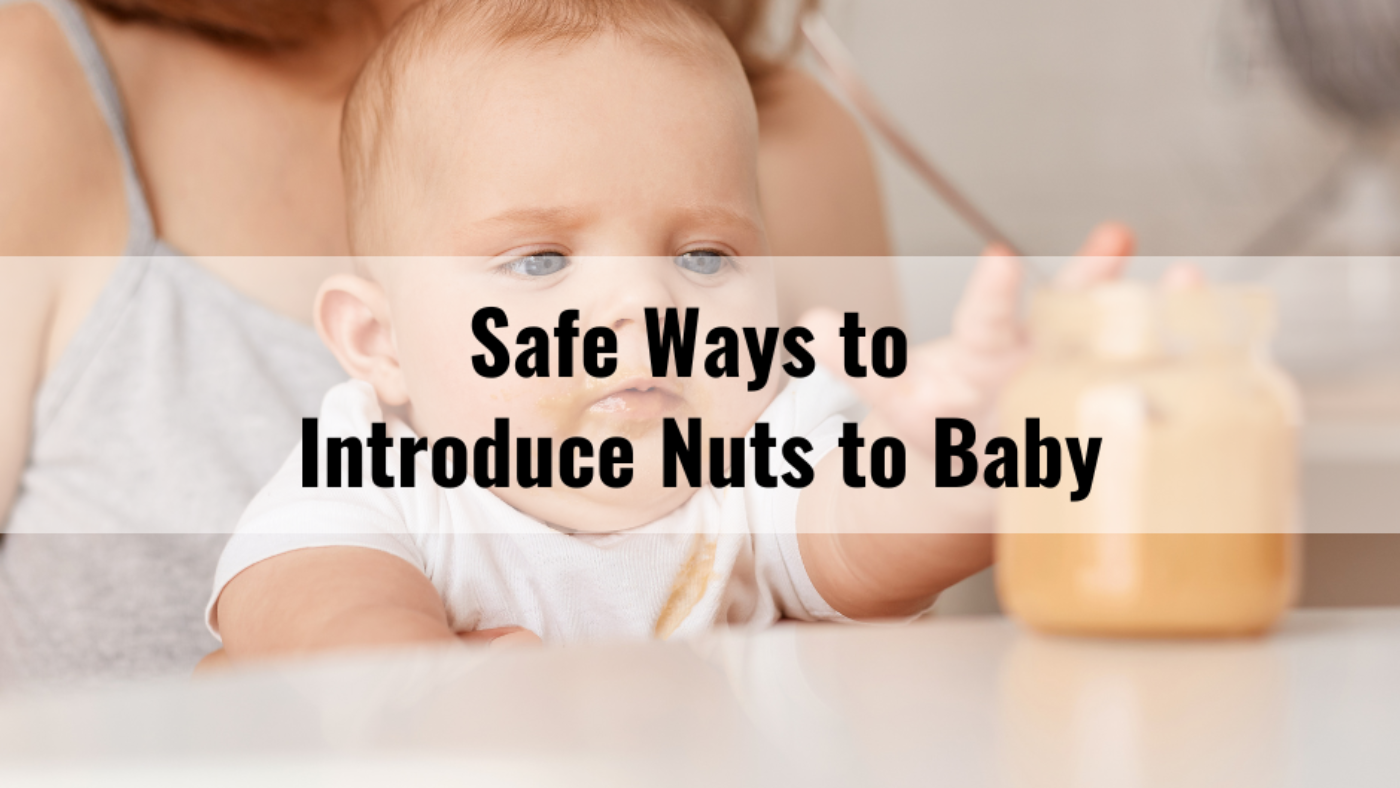
Leave A Comment